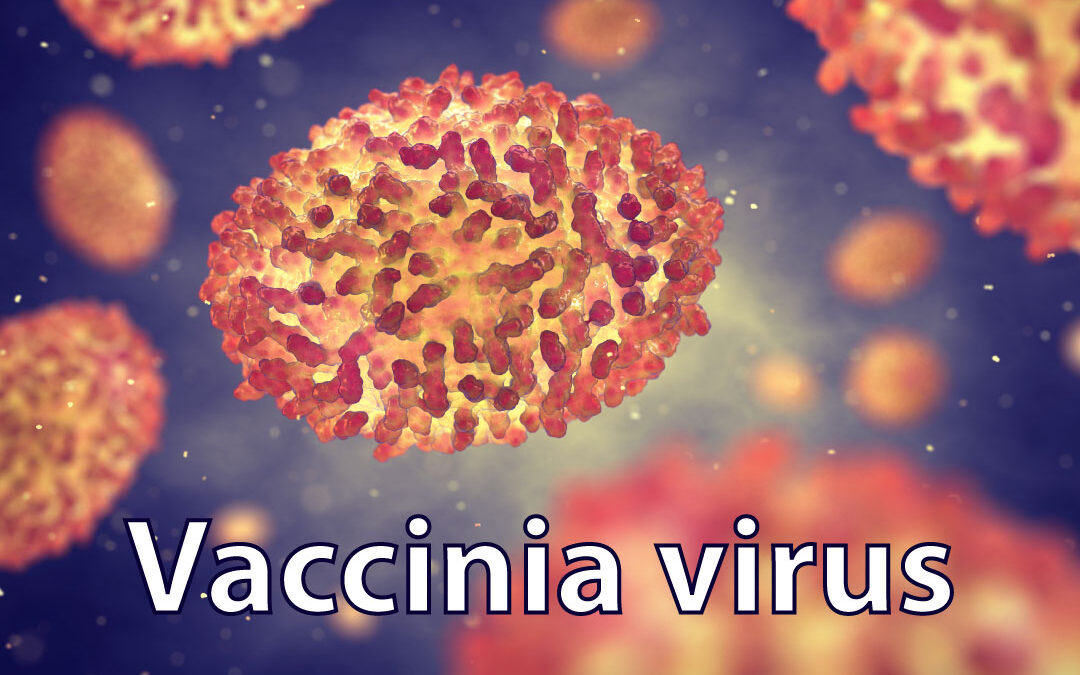Listen to this blog article
Smallpox virus (variola virus) is among the world’s most infamous viruses. At school, we all learn how the deadly smallpox virus was eliminated through vaccination. If you’d forgotten that particular biology lesson, perhaps you’ve seen Bill Gate’s reminder of the dangerous scenario of a bioterrorist attack using the smallpox virus.
This blog will discuss another virus of the same genus and family (Orthopoxvirus genus of the Poxviridaefamily) that has an equally important place in virology and vaccinology: vaccinia virus.
So, what makes the vaccinia virus so important?
The vaccinia virus is a much less dangerous relative of smallpox. In fact, it was the distant relative used for smallpox eradication. While smallpox killed around one in three infected, a rash and fever are the worst a healthy person might expect from a vaccinia virus infection. Although Edward Jenner used cowpox to immunize a 9-year-old boy against smallpox in 1796, the vaccinia virus (whose origin remains somewhat mysterious) ultimately became the basis for the smallpox vaccine. Because of its important role against smallpox, the vaccinia virus is among the most studied viruses and was heavily relied upon in the early efforts to view viruses under microscopes, grow viruses in labs, and purify, measure, and chemically describe viruses.
And today, the vaccinia virus is still widely used as a vector for recombinant DNA vaccines and as a ‘model’ enveloped virus in research. We’ll address these two important uses of the vaccinia virus below.
Vaccinia virus as a model enveloped virus
Life is super diverse – including viruses – and there just aren’t enough scientists (or funding!) to study how every virus behaves in every experiment. To get around this, scientists often rely on ‘model’ organisms (species that are extensively studied to understand particular biological phenomena). Vaccinia is a popular model enveloped virus (enveloped virus are those viruses that have an outer wrapping or ‘envelope’), not only because it can be grown relatively easily in low containment laboratories, but also because of the unusual number of membranes it picks up along its life cycle, which contribute to its stability. The vaccinia virus forms two distinct infectious virions that differ in the number of surrounding membranes. The first virion produced is called the intracellular mature virus (IMV) or mature virion (MV) and is surrounded by a single membrane that remains within the cell until cell lysis. The second virion produced can be found in two different forms, the extracellular enveloped virus (EEV or EV) and the cell-associated enveloped virus (CEV). Both EEV and CEV are surrounded by two membranes and are secreted from the cell before cell lysis. Being wrapped in host-derived membranes, EEV and CEV are relatively resistant to neutralization by antibodies and complement, and therefore seem to be better adapted to disseminate long-range infection (1)
Because of its complex structure and stability, vaccinia virus is relatively resistant to disinfectants and drying; for this reason, it is often used as a model when investigating the virucidal efficacy of alcoholic formulations for hand disinfectants (a feeble virus wouldn’t be as useful when trying to identify the best virus-killing agents).
Here at Virology Research Services, we often use the vaccinia virus in our research and industrial testing services. For example, a client might ask us to use the vaccinia virus as a model enveloped virus in one of our ISO (International Organization for Standardization) antiviral tests or in a suspension test or carrier test.
Vaccinia as a viral vector
The vaccinia virus is also important as a viral vector for live, recombinant vaccines. Not only does this virus replicate in the cytoplasm of infected cells, reducing the risk of integration of its double-stranded DNA genome, but it also has a sufficiently large genome to allow the introduction of even large antigens into the recipient’s host cells. In this way, it becomes possible to develop viral vector vaccines that target viruses unrelated to vaccinia. The modified vaccinia virus Ankara (MVA) is a licensed third-generation vaccine against smallpox, and MVA is also being used to develop viral vector vaccines. For example, in Scientific Reports, Pérez et al. (2018) (2) describe a vaccine based on a modified vaccinia virus Ankara vector that expresses Zika virus structural proteins and controls Zika virus replication in mice. Vaccinia virus vectors have also been used to develop and improve Leishmania, HBV, influenza, and tuberculosis vaccines. And, once again, the stability of vaccinia virus at room temperature represents an attractive feature to vaccine developers.
Another and not less important feature is the large number of immunomodulatory genes encoded by the vaccinia virus: an arsenal of viral proteins that have evolved to suppress or fine-tune various innate and adaptive immune system components. These immunomodulatory genes can be exploited to maximise vaccine effectiveness, and their study can reveal previously unknown functions of our own immune system, like the sentinel role of certain cellular DNA sensors and the antiviral role of cytokines like IL-1 β (3).
With its wide use in research and therapeutics, even after smallpox eradication, vaccinia virus clearly has an important role in our fight against less harmless viruses. Nevertheless, we all hope the vaccinia virus will never again need to be used for the reason it was first deployed!
We hope you’ve enjoyed this introduction to vaccinia virus. If you have any questions or are interested in any of our virus testing and research services, please get in touch using the contact form below or email us at vrs@virologyresearchservices.com.
References
- Vaccinia virus morphogenesis and dissemination, Roberts & Smith, 2008
- A Vaccine Based on a Modified Vaccinia Virus Ankara Vector Expressing Zika Virus Structural Proteins Controls Zika Virus Replication in Mice, Perez et al, 2018
- Vaccinia virus immune evasion: mechanisms, virulence and immunogenicity, Smith et al, 2013
Blog by Thais Fuscaldi Reboucas
Edited by Reckon Better Scientific Editing




